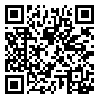BibTeX | RIS | EndNote | Medlars | ProCite | Reference Manager | RefWorks
Send citation to:
URL: http://jrsm.khu.ac.ir/article-1-2420-en.html
2- Tehran University ,
Measuring instrument of interpersonal and intrapersonal motor coordination has designed and built to provide information about the human movements’ coordination in reach of researchers, trainers and therapists. To evaluate the validation of this instrument with using of Vienna two hands coordination test and present research instrument were asked 28 participants to do the task of two hands, two feet and interpersonal movement coordination. Pearson correlation test showed that the present research instrument has high validation in motor coordination of two hands in total time mean factor of joystick (r =0/88), knob (r =0/96) and in error percentage mean factor of joystick (r =0/89) and knob (r =0/87). Also the results of Cronbach’s alpha showed that present research instrument has appropriate reliability in motor coordination of two hands in total time mean factor of joystick (r =0/89) and knob (r =0/97) and in error time percentage mean factor of joystick (r =0/81) and knob (r =0/85). Also results indicated acceptable reliability in motor coordination of two feet in total time mean factor of pedals (r =0/90) and in error time percentage mean factor of pedals (r =0/83) and in interpersonal motor coordination in total time mean factor (r =0/91) and in error time percentage mean factor (r =0/80). Therefore using the present study instrument can be offered to sports science laboratories in all higher education institutions, federations and coaches, patients and rehabilitation centers, health and physiotherapy clinics.
Received: 2016/12/25 | Accepted: 2017/08/1 | Published: 2020/08/31
| Rights and permissions | |
 | This work is licensed under a Creative Commons Attribution-NonCommercial 4.0 International License. |








